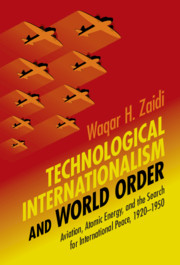 Technological Internationalism and World Order
Technological Internationalism and World Order Book contents
- Technological Internationalism and World Order
- Science in History
- Technological Internationalism and World Order
- Copyright page
- Dedication
- Contents
- Figures
- Acknowledgements
- Abbreviations
- Introduction: Machines of Peace
- 1 Invention, Interdependence, and the Lag
- 2 Controlling Scientific War
- 3 The Shape of Things to Come
- 4 Air Power for a United Nations
- 5 Wings for Peace: Planning for the Post-War Internationalization of Civil Aviation
- 6 A Battle for Atomic Internationalism: United States and the International Control of Atomic Energy
- 7 A Blessing in Disguise: Britain and the International Control of Atomic Energy
- Conclusion: Science, Technology, and Internationalism into the Cold War and Beyond
- Bibliography
- Index
Conclusion: Science, Technology, and Internationalism into the Cold War and Beyond
Published online by Cambridge University Press: 25 May 2021
- Technological Internationalism and World Order
- Science in History
- Technological Internationalism and World Order
- Copyright page
- Dedication
- Contents
- Figures
- Acknowledgements
- Abbreviations
- Introduction: Machines of Peace
- 1 Invention, Interdependence, and the Lag
- 2 Controlling Scientific War
- 3 The Shape of Things to Come
- 4 Air Power for a United Nations
- 5 Wings for Peace: Planning for the Post-War Internationalization of Civil Aviation
- 6 A Battle for Atomic Internationalism: United States and the International Control of Atomic Energy
- 7 A Blessing in Disguise: Britain and the International Control of Atomic Energy
- Conclusion: Science, Technology, and Internationalism into the Cold War and Beyond
- Bibliography
- Index
Summary
The age of peace through technology never arrived. The facets of international relations that so horrified internationalists in the first half of the twentieth century remain with us today. International politics is as anarchic today as it was in the 1930s and 1940s: although there are socially constructed international norms and complex interdependence, strongly competing national interests continue to dominate.1 Wars continue to bring suffering to millions; international organizations which once promised freedom from sovereign state interests remain largely beholden to these very same interests; and the ordered worlds of internationally planned resources or free trade remain ideals distant from the current jumble of bilateral and multilateral trade and economic treaties. The weak multilateral response to crises such as climate change and the recent Covid-19 pandemic point to little cooperation even in matters related to science.
- Type
- Chapter
- Information
- Technological Internationalism and World OrderAviation, Atomic Energy, and the Search for International Peace, 1920–1950, pp. 239 - 247Publisher: Cambridge University PressPrint publication year: 2021
- 1
- Cited by
